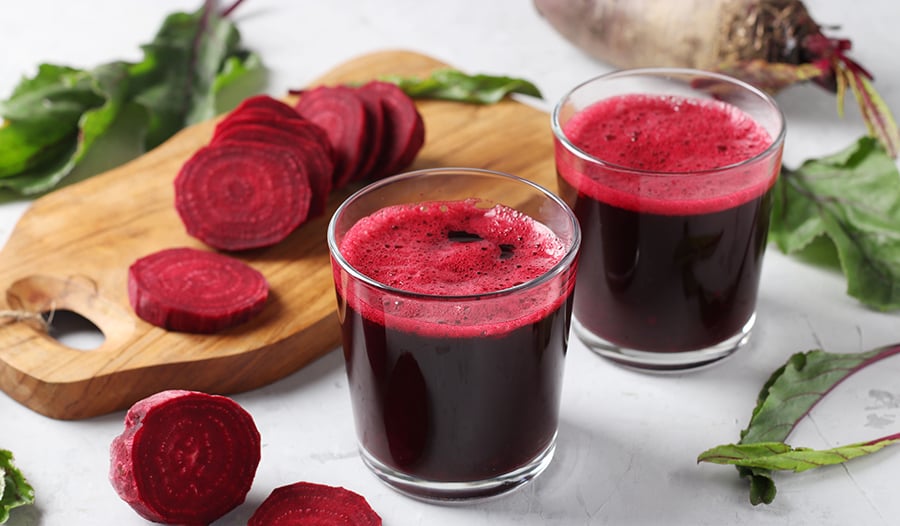Top 10 Nitric Oxide Foods

Nitric oxide is a gas naturally produced within the body that acts as a vasodilator, helping to improve blood flow. Proper blood flow is essential for optimal tissue and organ health. Specific foods and supplements can help boost the body’s natural nitric oxide levels.
What Is Nitric Oxide?
Nitric Oxide is a gas made naturally in the body by combining nitrogen and oxygen. Its main role is to support blood vessel health by helping dilate blood vessels, raise blood supply, and lower blood pressure.1
Vasodilation is the widening of blood vessels, which allows more blood to flow through the vessels. Nitric oxide works by relaxing the inner muscles of blood vessels, allowing them to widen and increase blood flow. Healthy vasodilation is important for optimal health, as it allows oxygen and nutrients to reach tissues and organs within the body, supporting their function.2
As a supporter of blood vessel health, nitric oxide offers a host of benefits throughout the body. Studies suggest nitric oxide may help decrease muscle soreness, treat erectile dysfunction, boost exercise performance, and even help manage type 2 diabetes.
While nitric oxide cannot be found in supplements or foods, a number of supplements and foods support the body’s own production of nitric oxide. Eating a diet high in antioxidants along with nitrate-rich foods can support nitric oxide production. Two amino acids, L-arginine and L-citrulline, which are found in some foods or as supplements, also support nitric oxide production.
Studies show that a diet rich in naturally occurring nitrates may improve athletic performance and reduce your risk of chronic and diet-related diseases. Conversely, eating a diet high in added nitrites or nitrates may increase the risk of disease.
Many foods that naturally contain nitrates also contain antioxidants like vitamin C, which helps the body make nitric oxide instead of nitrosamines. When foods with added nitrates and nitrites—like commercially processed hot dogs, deli meats, bacon, and ham—are consumed, the nitrates break down into nitrosamines. Nitrosamines are a known carcinogen and may increase the risk of certain types of cancer when consumed frequently.3,4 Eating processed meat has also been associated with various cancers, including colon, breast, liver, and lung cancers, as well as increased risk of diabetes and heart disease.5–7
To support healthy nitric oxide levels and reduce nitrosamines levels, eat vegetables that naturally contain nitrates and are rich in vitamin C, while minimizing or eliminating your intake of processed meats.
Top Foods to Boost Nitric Oxide
Nitric oxide gas is made from natural sources of nitrates and nitrites in our food, such as dark leafy greens, citrus fruits, meat, poultry, seafood, nuts and seeds, chocolate, and wine. By consuming a nitrate-rich diet, a person can naturally support their own nitric oxide levels.
Spinach
Leafy green vegetables like spinach, along with kale, arugula, and Swiss chard, have higher nitrate concentrations than other vegetables. Spinach can be consumed fresh and eaten raw in salads, sandwiches, or wraps. Spinach is also excellent steamed as a side dish or cooked with eggs, soups, stews, or sauces. You can also use spinach in baking, adding it to muffins or breads for a boost of iron, fiber, and nitrates! Lastly, spinach can also be purchased or stored frozen for convenience and to help prevent food waste.
If you don’t get much spinach in your diet, you can still benefit from its nutritional properties through spinach powders or capsules.
Beets
Beets are a colorful root vegetable rich in antioxidants, fiber, and nitrates. Beets can be juiced raw for a colorful, hydrating beverage or fermented into sauerkraut, a gut-healthy condiment. Beets can also be baked in muffins, breads, cakes, pancakes, or waffles, providing a vibrant pink or red hue to your recipe!
Beets are commonly peeled and cooked for soups, salads, or side dishes. For those who don’t enjoy the taste of beets, a beet powder supplement is an excellent way to conveniently and consistently benefit from the nutritional benefits of beets!
Naturally high in nitrates that support blood vessel health, studies suggest beets and beet powders may support athletic endurance and increase a person's ability to handle high-intensity exercise.
Garlic
Garlic has many powerful medicinal properties, thanks to a natural compound in garlic known as allicin. Garlic is also a great source of nitrates, helping boost nitric oxide levels, even when consumed in small amounts! Garlic is mostly commonly enjoyed cooked and is often used in savory recipes, such as soups, stews, sauces, salad dressings, marinades, and savory baked recipes. Garlic can also be consumed in powder or capsule form.
Additional health benefits of garlic include immune function support, helping lower blood pressure and cholesterol levels, supporting athletic performance, gut health, and bone health, and possibly helping the body detoxify against heavy metals.
Carrots
Carrots provide many health benefits, including supporting eye health, digestion, heart health, immune function, skin health, and healthy cholesterol levels. Carrots are rich in beta carotene, a compound that gives carrots their orange color and is converted into vitamin A within the body.
Vitamin A plays many important roles in the body, such as supporting eye health, immune health, growth, development, and reproductive health. Additional foods rich in beta-carotene include cantaloupe, pumpkins, mangoes, peaches, and apricots. Carrots are also fibrous vegetables and a source of nitrates.
Meat, Poultry, and Seafood
Meat, poultry, and seafood are all sources of protein, an essential macronutrient for growth, development, bone health, muscle health, cognitive function, and weight management. Meat, chicken, and seafood are also great options for boosting nitric oxide levels.
Processed meats contain higher levels of nitrates, often due to nitrates or nitrites added to the meat to help prevent bacterial growth. Added nitrates or nitrates also give processed meat a pink or reddish hue. Therefore, fresh, quality meat, poultry, and seafood is a healthier option for naturally boosting nitric oxide levels. Pairing meats with fruits and vegetables rich in vitamin C can also help the body break nitrates down into nitric oxide.
Baking, grilling, roasting, and steaming are all delicious ways to prepare meat, poultry, and seafood. Check out these tips for healthier grilling.
Dark Chocolate
Dark chocolate is made with a higher percentage of cacao beans than white or milk chocolate. Cacao is not only delicious but also offers incredible health benefits, like supporting cardiovascular health, boosting mood, reducing inflammation, and supporting cognitive function.
For those with a sweet tooth, chocolate is a wonderful choice for satisfying a sweet craving while supporting one’s health. In addition to being a source of nitrates, cacao is rich in magnesium, iron, calcium, zinc, copper, potassium, manganese, and flavanols.
Cacao flavonoids may help lower blood pressure, prevent clots, and support healthy blood flow to the heart and brain. Cacao can be enjoyed as a dark chocolate bar, dark chocolate chips, or cacao powder to mix into smoothies, baked recipes, hot chocolate, or even in savory recipes like mole sauce.
Citrus Fruits
Citrus fruits may seem like an unlikely source of nitrates—but this water-dense, fibrous fruit is a great way to help boost the body’s nitric oxide levels. While there are many different types of citrus fruits, common varieties for snacking, cooking, and baking include oranges, tangerines, lemons, limes, and grapefruits.
Citrus fruits are incredibly versatile for both sweet and savory recipes and can be used in cooking, baking, smoothies, desserts, popsicles, salads, or for snacking. Another key health benefit of citrus fruits is their high vitamin C content. This powerful antioxidant nutrient is essential for helping the body break down nitrates into nitric oxide.
Nuts and Seeds
Nuts and seeds are a source of two main macronutrients—protein and fat—and fiber. Walnuts, almonds, pistachios, sunflower seeds, and chia seeds also contain nitrates. Walnuts, in particular, contain the amino acid L-arginine, which helps the body convert nitrates into nitric oxide.
Nuts and seeds are great staples for gut health, heart health, and immune health. Nuts like almonds are also rich in the antioxidant vitamin E. Seeds like chia seeds are a source of omega-3 fatty acids, which support brain and heart health.
Celery
Celery is a water-dense root vegetable that is packed with fiber and is a source of nitrates. Celery is also a source of vitamin K and small amounts of calcium, iron, and vitamin A. Celery is a great snack with almond butter or peanut butter, diced in a salad, soup, or stew, juiced, or added to a smoothie!
Red Wine
Red wine, more so than white wine, is another source of nitrates, antioxidants, and resveratrol. Resveratrol is a natural phenol in red wine that has antioxidant and anti-inflammatory properties.
While red wine may help increase nitric oxide levels in the body, it is still a source of alcohol, which provides no nutritional benefit. According to The World Health Organization (WHO), no amount of alcohol is considered safe for human consumption due to the long-term and well-documented negative health impacts of alcohol consumption.8
Potential Symptoms of Low Nitric Oxide
Low nitric oxide levels impact blood circulation, reduce blood flow to the brain, organs, and tissues, and can result in symptoms such as:
- Depression
- Fatigue
- Poor Sleep Quality
- Reduced Libido
- Poor Vision
- Hypertension
- Memory Loss
Takeaway
Nitric oxide is a vasodilator that supports healthy blood flow, which in turn supports the health and optimal function of all organs and systems within the body. Eating a diet rich in real, whole foods like fruits, vegetables, nuts, seeds, and quality, wholesome meat and seafood is a great way to help boost the body’s nitric oxide levels naturally.
Avoid eating nitrates or nitrites that are added to foods like processed meats. They break down into nitrosamines, which are known carcinogens and may increase cancer risk.
To enjoy the health benefits of naturally occurring nitrates, add spinach, beets, carrots, garlic, poultry, seafood, dark chocolate, citrus fruits, nuts, seeds, and celery to your weekly grocery shopping cart!
References:
- Lundberg JO, Weitzberg E. Nitric oxide signaling in health and disease. Cell. 2022;185(16):2853-2878.
- Ramanlal R, Gupta V. Physiology, Vasodilation. StatPearls. Published online January 23, 2023. Accessed July 16, 2024.
- Brown JL. N-Nitrosamines. Occup Med. 1999;14(4):839-848.
- Song P, Wu L, Guan W. Dietary Nitrates, Nitrites, and Nitrosamines Intake and the Risk of Gastric Cancer: A Meta-Analysis. Nutrients. 2015;7(12):9872-9895.
- Anderson JJ, Darwis NDM, Mackay DF, et al. Red and processed meat consumption and breast cancer: UK Biobank cohort study and meta-analysis. Eur J Cancer. 2018;90:73-82.
- Cross AJ, Leitzmann MF, Gail MH, Hollenbeck AR, Schatzkin A, Sinha R. A prospective study of red and processed meat intake in relation to cancer risk. PLoS Med. 2007;4(12):1973-1984.
- Micha R, Wallace SK, Mozaffarian D. Red and processed meat consumption and risk of incident coronary heart disease, stroke, and diabetes mellitus: a systematic review and meta-analysis. Circulation. 2010;121(21):2271-2283.
- No level of alcohol consumption is safe for our health. World Health Organization. Accessed July 22, 2024.
DISCLAIMER:This Wellness Hub does not intend to provide diagnosis...

















































































 Table of Contents
Table of Contents

